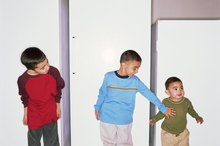4 Causes of Family Conflict
Family harmony provides a sense of belonging and a feeling of security unlike many other types of relationships. When conflict arises, it threatens that security. Whether the disharmony initiates from within the family unit or from external sources, individual family members and the family as a whole can experience a range of negative emotions and consequences. Unresolved conflict may irreparably damage a marriage and the entire family if family members do not seek help.
Finances and Jobs
One major source of family conflict is within the area of finances--specifically, the lack of enough money to pay bills, maintain the mortgage or rent, buy sufficient food and other necessities and have any remaining money for recreation 2. job or career may contribute to conflict within a family. If a parent’s job keeps him away from home most of the time, the spouse at home with the children often feels neglected or overwhelmed. Conversely, if the parent becomes unemployed, this causes its own form of stress and conflict, as finances dwindle and uncertainty sets in about the future.
- One major source of family conflict is within the area of finances--specifically, the lack of enough money to pay bills, maintain the mortgage or rent, buy sufficient food and other necessities and have any remaining money for recreation 2.
- Conversely, if the parent becomes unemployed, this causes its own form of stress and conflict, as finances dwindle and uncertainty sets in about the future.
Sibling Rivalry
Things to Do for Underprivileged Kids
Learn More
Another cause of family conflict is the inevitable rivalry that occurs between siblings. Children typically seek their parents’ attention and approval, even if this requires tattling on, or sometimes causing harm to, a sibling. Whether a child expresses jealousy of her sibling, competes with him or teases him non-stop, it is destined to cause conflict. Each child deserves an equal amount of parental love and acceptance, yet sometimes a parent may favor one child over another. This merely intensifies the conflict.
- Another cause of family conflict is the inevitable rivalry that occurs between siblings.
- Whether a child expresses jealousy of her sibling, competes with him or teases him non-stop, it is destined to cause conflict.
Child Discipline
While mutual agreement on the subject of child discipline is crucial, the lack of consensus opens up another potential area for family conflict. If one parent acts as the “disciplinarian,” the other parent typically becomes the “consoler” to whom the children turn -- this often pits one parent against the other.
In-Laws and Extended Family
The Role of an Uncle
Learn More
Jokes and movies abound regarding conflict with in-laws (especially mothers-in-law); however, when you actually become involved in disagreements with your in-laws or extended family, it is no laughing matter. While it is preferable to respect your elders--parents and grandparents on both sides equally--this can prove to be challenging. If relatives routinely interfere in your family’s decisions and lifestyle, conflict frequently results.
Related Articles
References
- Marriage and Family Encyclopedia: Conflict - Couple Relationships, Family Relationships, Parent-Child Relationships
- The Conflict Resolution Information Source: Family Conflict
- Self Growth: Some Reasons for Family Conflict
- Help Guide: Job Loss and Unemployment Stress
- Help Guide.org: Child Abuse and Neglect
- American Psychological Association. How Stress Affects Your Health. Updated 2013.
- American Psychological Association. How Stress Affects Your Health. Updated 2013.
- Shonk K. 3 Types of Conflict and How to Address Them. Program on Negotiation at Harvard Law School. Updated March 26, 2020.
- Thomas PA, Liu H, Umberson D. Family relationships and well-being. Innov Aging. 2017;1(3). doi:10.1093/geroni/igx025
- Jones RG. Chapter 6.2: Conflict and Interpersonal Communication. In: Communication in the Real World. 2013.
- Newsom J, Mahan T, Rook TL, KS, Krause N. Stable negative social exchanges and health. Health Psychology. 2008;27(1)78-86. doi:10.1037/0278-6133.27.1.78
- Hannibal KE, Bishop MD. Chronic stress, cortisol dysfunction, and pain: A psychoneuroendocrine rationale for stress management in pain rehabilitation. Phys Ther. 2014;94(12):1816-25. doi:10.2522/ptj.20130597
- Golabchi A, Sarrafzadegan N. Takotsubo cardiomyopathy or broken heart syndrome: A review article. J Res Med Sci. 2011;16(3):340-5. PMID:22091255
- Bernstein MJ, Claypool HM. Social exclusion and pain sensitivity: Why exclusion sometimes hurts and sometimes numbs. Pers Soc Psychol Bull. 2012;38(2):185-96. doi:10.1177/0146167211422449
- Harburg E, Kaciroti N, Gleiberman L, Schork, MA, Julius, M. Marital pair anger coping types may act as an entity to affect mortality: Preliminary findings from a prospective study. Journal of Family Communication. January 2008. doi:10.1080/15267430701779485.
- Staicu ML, Cuţov M. Anger and health risk behaviors. J Med Life. 2010;3(4):372-5. PMID:21254733
- Overall NC, Mcnulty JK. What type of communication during conflict is beneficial for intimate relationships?. Curr Opin Psychol. 2017;13:1-5. doi:10.1016/j.copsyc.2016.03.002
- Zacchilli TL, Hendrick C, Hendrick SS. The romantic partner conflict scale: A new scale to measure relationship conflict. Journal of Social and Personal Relationships. 2009;26(8):1073-1096. doi:10.1177/0265407509347936
- Barnes S, Brown KW, Krusemark E, Campbell WK, Rogge RD. The role of mindfulness in romantic relationship satisfaction and responses to relationship stress. J Marital Family Therapy. 2007;33(4):482-500. doi:10.1111/j.1752-0606.2007.00033.x
- Jones SM, Bodie GD, Hughes SD. The impact of mindfulness on empathy, active listening, and perceived provisions of emotional support. Communication Research. 2019;46(6):838-865. doi:10.1177/0093650215626983
- Schofield MJ, Mumford N, Jurkovic D, Jurkovic I, Bickerdike A. Short and long-term effectiveness of couple counselling: A study protocol. BMC Public Health. 2012;12:735. doi:10.1186/1471-2458-12-735
- Hofmann SG, Asnaani A, Vonk IJ, Sawyer AT, Fang A. The efficacy of cognitive behavioral therapy: A review of meta-analyses. Cognit Ther Res. 2012;36(5):427-440. doi:10.1007/s10608-012-9476-1
- Stress and Heart Health. American Heart Association. Reviewed June 17, 2014.
- Chapman BP, Fiscella K, Kawachi I, Duberstein P, Muennig P. Emotion suppression and mortality risk over a 12-year follow-up. J Psychosom Res. 2013;75(4):381-5. doi:10.1016/j.jpsychores.2013.07.014
- Chen Y, Lyga J. Brain-skin connection: Stress, inflammation and skin aging. Inflamm Allergy Drug Targets. 2014;13(3):177-90. doi:10.2174/1871528113666140522104422
- Goyal S, Gupta G, Thomas B, Bhat KM, Bhat GS. Stress and periodontal disease: The link and logic. Ind Psychiatry J. 2013;22(1):4-11. doi:10.4103/0972-6748.123585
- Sturgeon JA, Zautra AJ. Social pain and physical pain: Shared paths to resilience. Pain Manag. 2016;6(1):63-74. doi:10.2217/pmt.15.56
- The American Institute of Stress. 50 Common Signs and Symptoms of Stress. Updated June 16, 2020.
Writer Bio
K'Lee Banks started writing professionally in 1984. She has written content for Writer Access, WiseGEEK, Travel New England and numerous private clients. Banks has a background in education and social services. She is also an entrepreneur who makes customized quilts and crafts. Banks has a Master of Education from American InterContinental University and is pursuing a doctorate in education from Northcentral University.









